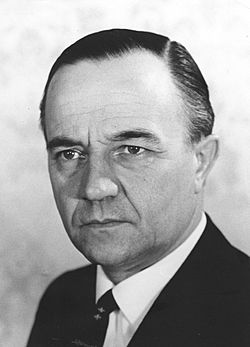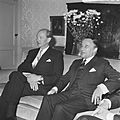Piet de Jong facts for kids
Quick facts for kids
DSC LVO
Piet de Jong
|
|
|---|---|

De Jong in 1970
|
|
| Prime Minister of the Netherlands | |
| In office 5 April 1967 – 6 July 1971 |
|
| Monarch | Juliana |
| Deputy | Johan Witteveen Joop Bakker |
| Preceded by | Jelle Zijlstra |
| Succeeded by | Barend Biesheuvel |
| Parliamentary leader in the Senate |
|
| In office 11 May 1971 – 17 September 1974 |
|
| Preceded by | Jan Niers |
| Succeeded by | Jan Teijssen |
| Parliamentary group | Catholic People's Party |
| Member of the Senate | |
| In office 11 May 1971 – 17 September 1974 |
|
| Parliamentary group | Catholic People's Party |
| Member of the House of Representatives |
|
| In office 23 February 1967 – 5 April 1967 |
|
| Parliamentary group | Catholic People's Party |
| Minister of Defence | |
| In office 24 July 1963 – 5 April 1967 |
|
| Prime Minister |
See list
|
| Preceded by | Sim Visser |
| Succeeded by | Willem den Toom |
| State Secretary for Defence | |
| In office 25 June 1959 – 24 July 1963 Serving with Michael Calmeyer
|
|
| Prime Minister | Jan de Quay |
| Preceded by | Harry Moorman |
| Succeeded by | Adri van Es |
| Personal details | |
| Born |
Petrus Jozef Sietse de Jong
3 April 1915 Apeldoorn, Netherlands |
| Died | 27 July 2016 (aged 101) The Hague, Netherlands |
| Political party | Christian Democratic Appeal (from 1980) |
| Other political affiliations |
Catholic People's Party (1959–1980) |
| Alma mater | Royal Naval College |
| Occupation | Politician · Diplomat · Naval officer · Businessperson · Corporate director · Nonprofit director |
| Awards | Order of Orange-Nassau (Knight Grand Cross) Bronze Cross (2) Distinguished Service Cross Medal for Order and Peace War Memorial Cross |
| Military service | |
| Allegiance | |
| Branch/service | Royal Netherlands Navy |
| Years of service | 1931–1959 (Active duty) 1959–1963 (Reserve) |
| Rank | |
| Unit | Royal Netherlands Navy Submarine Service |
| Commands | HNLMS O 24 HNLMS De Zeeuw HNLMS Gelderland |
| Battles/wars | |
| Aide-de-camp | Queen Juliana (1955–1958) |
| Chief of staff | Inspector General of the Navy Prince Bernhard (1955–1958) |
Piet de Jong (born Petrus Jozef Sietse de Jong; April 3, 1915 – July 27, 2016) was a Dutch politician and naval officer. He was a member of the Catholic People's Party (KVP), which later became the Christian Democratic Appeal (CDA). De Jong served as the Prime Minister of the Netherlands from 1967 to 1971.
He began his career in the Royal Netherlands Navy and was part of the Submarine Service. During World War II, he bravely served on the submarine HNLMS O 24. After the war, he continued his naval career before entering politics. He became the State Secretary for Defence in 1959 and then the Minister of Defence in 1963. In 1967, he became Prime Minister.
De Jong's time as Prime Minister is remembered as very successful. His government was the first since World War II to complete a full four-year term without major problems. He was known for being a good leader and a skilled negotiator. Even after leaving office, he remained active in public life and continued to share his opinions on political matters until his death at 101 years old.
Contents
Piet de Jong was born on April 3, 1915, in Apeldoorn, Netherlands. He came from a Roman Catholic family. In 1931, at age 16, he joined the Royal Netherlands Navy. He attended the Royal Netherlands Naval College in Den Helder. In 1934, he became a Sub-lieutenant.
Serving in World War II
After graduating, Piet de Jong served briefly in the Dutch East Indies. He then joined the Royal Netherlands Navy Submarine Service. When Nazi Germany invaded the Netherlands in May 1940, De Jong was a Lieutenant junior grade. He was given command of the submarine HNLMS O 24. His mission was to take the submarine to a naval base in Portsmouth, England. He successfully completed this dangerous journey. For his bravery, he received the Bronze Cross on July 16, 1940.
De Jong served as the First Officer on HNLMS O 24 from 1940 to 1944. He fought in the Battle of the Atlantic and later in the Pacific War. He earned a second Bronze Cross for bravery in 1943. In October 1944, he was promoted to Lieutenant commander and became the commanding officer of HNLMS O 24.
After World War II ended, De Jong continued to serve in the Royal Netherlands Navy. He held various important roles. In 1951, he commanded the frigate HNLMS De Zeeuw. In 1953, he was promoted to Commander. He became chief of staff to Prince Bernhard, who was the Inspector General of the Navy. He also served as a senior assistant to Queen Juliana. In 1958, he was promoted to Captain and commanded the destroyer HNLMS Gelderland.
Entering Politics
In 1959, while on a naval exercise, Piet de Jong received an unexpected order. He was asked to become the State Secretary for Defence. This role focused on naval affairs. He accepted the position and started his political career on June 25, 1959.
Becoming Minister of Defence
After serving as State Secretary, De Jong became the Minister of Defence. He held this important role in several governments from 1963 to 1967.
Prime Minister of the Netherlands
On April 5, 1967, Piet de Jong became the Prime Minister of the Netherlands. He also served as the Minister of General Affairs. His government, known as the Cabinet De Jong, was notable because it completed its full four-year term without any major crises. This was a rare achievement after World War II.
During his time as Prime Minister, his government faced several challenges and made important changes:
- They worked on making colleges and universities more democratic.
- They tried to modernize politics, but some plans were not fully put into action.
- They dealt with economic issues like rising prices and inflation.
- They improved relations with Indonesia, a former Dutch colony.
- They handled protests against the Vietnam War.
- They increased the defense budget after the Soviet Union invaded Czechoslovakia.
De Jong met with many world leaders, including U.S. President Richard Nixon and French Presidents Charles de Gaulle and Georges Pompidou. He was also present when Prince Willem-Alexander, the current King of the Netherlands, was born in 1967.
After the 1971 election, De Jong left office on July 6, 1971. He continued to be active in politics, serving as a member and leader in the Senate until 1974.
Life After Politics
After leaving active politics in 1974, Piet de Jong took on many roles in businesses and non-profit organizations. He also served on government committees and as a diplomat.
He continued to share his views on political matters. For example, in 2010, he spoke out against a proposed government coalition that included the Party for Freedom (PVV), because he disagreed with their views on freedom of religion. In 2012, he joined other former politicians in protesting cuts to the international development budget. He even said he would leave his party, the CDA, if the cuts were made.
Piet de Jong was present at the ceremony when Willem-Alexander became King of the Netherlands on April 30, 2013. At 98 years old, he was the oldest person attending the event.
His Reputation and Legacy
During his time as Prime Minister, some people thought Piet de Jong was old-fashioned. This was partly because he often wore a bowler hat, a custom he picked up while living in England during World War II. However, many ordinary citizens were happy with his government's policies.
Years later, De Jong is seen as one of the best prime ministers in Dutch history. Many politicians and experts praise his thoughtful decisions and his ability to lead effectively, even during times of social change. He is remembered as a team leader with a good sense of humor, who managed to keep things stable during a period of unrest.
Personal Life
After World War II, Piet de Jong married Anna Geertruida Jacoba Henriëtte "Anneke" Bartels. She was a former resistance fighter. They married on June 26, 1947, and had three children: Maria, Jos, and Gijs. Anneke Bartels passed away in 2010.
Longevity
Piet de Jong lived to be 101 years old. He was the oldest living former Prime Minister of the Netherlands. He was also the second longest-lived Prime Minister in Dutch history, after Willem Drees.
Death
Piet de Jong died on July 27, 2016, at his home in The Hague. He was 101 years old. He was survived by his three children, eight grandchildren, and fifteen great-grandchildren.
Military Ranks
| Rank | Date |
|---|---|
| 1931 | |
| 1934 | |
| 1936 | |
| 1944 | |
| 1953 | |
| 1958 |
Decorations
| Military Decorations | ||||
| Ribbon bar | Decoration | Country | Date | Comment |
|---|---|---|---|---|
| Bronze Cross (2) | Netherlands | 16 July 1940 / 8 July 1943 | ||
| War Memorial Cross | Netherlands | |||
| Medal for Order and Peace | Netherlands | |||
| Distinguished Service Cross | United Kingdom | |||
| Commander of the Order of the Sword | Sweden | |||
| Order of Naval Merit | Argentina | |||
| United Nations Korea Medal | United Nations | |||
| Honours | ||||
| Ribbon bar | Honour | Country | Date | Comment |
| Grand Officer of the Order of the House of Orange | Netherlands | 1958 | ||
| Knight Grand Cross of the Order of Orange-Nassau | Netherlands | 17 July 1971 | ||
| Grand Cross of the Order of Leopold II | Belgium | |||
| Grand Cross of the Order of Bernardo O'Higgins | Chile | |||
| Lieutenant of the Royal Victorian Order | United Kingdom | |||
| Officer of the Order of the Star of Africa | Liberia | |||
| Grand Decoration of Honour in Silver of the Decoration of Honour for Services to the Republic |
Austria | |||
Images for kids
-
Taoiseach of Ireland Jack Lynch and Prime Minister Piet de Jong during a meeting at the Ministry of General Affairs on 22 June 1967.
-
Secretary of State for Foreign of the United Kingdom George Brown, Prime Minister Piet de Jong, Prime Minister of the United Kingdom Harold Wilson and Minister of Foreign Affairs Joseph Luns at 10 Downing Street on 19 February 1968.
-
Prime Minister of Luxembourg Pierre Werner, Prime Minister Piet de Jong and Prime Minister of Belgium Gaston Eyskens during a Benelux conference in The Hague on 28 April 1968.
-
Prime Minister Piet de Jong and Chancellor of West-Germany Willy Brandt at Ypenburg Airport on 1 December 1969.
-
Prime Minister of Lesotho Leabua Jonathan and Prime Minister Piet de Jong during a meeting at the Ministry of General Affairs on 4 November 1970.
-
Prime Minister Mark Rutte and Piet de Jong during a meeting in Het Torentje on 7 March 2011.
See also
 In Spanish: Piet de Jong para niños
In Spanish: Piet de Jong para niños









